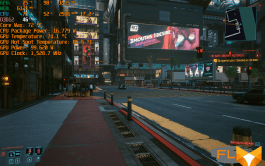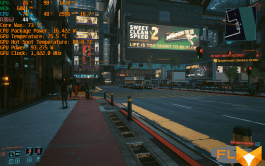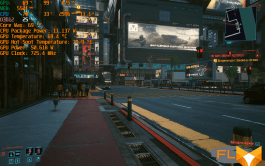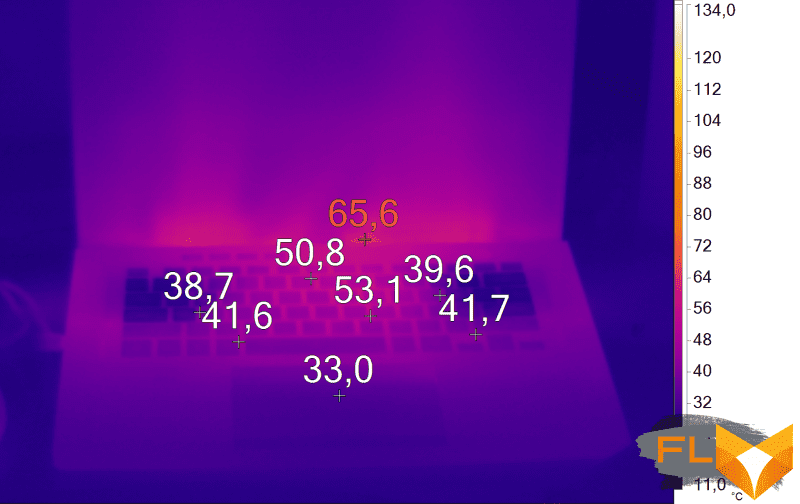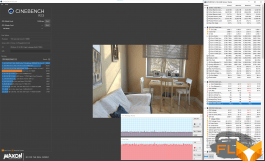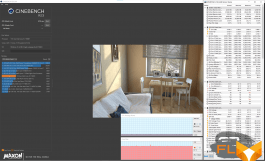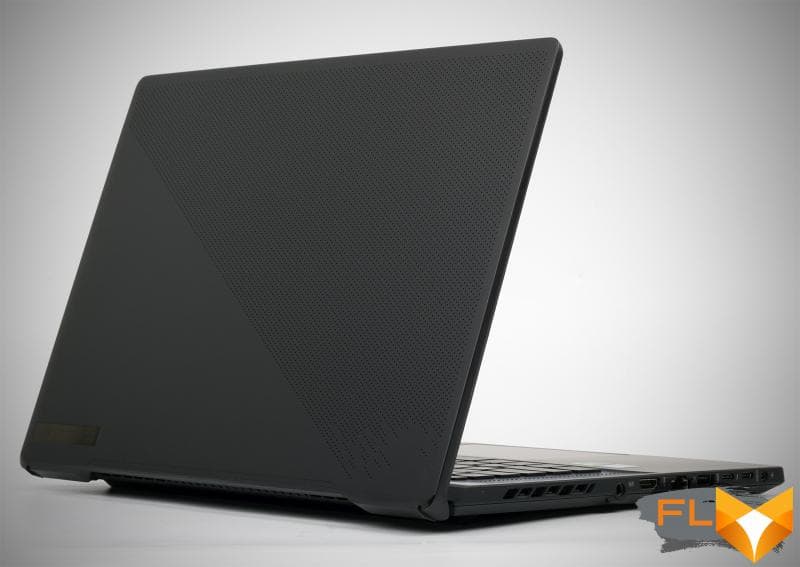


I had just handed in my review of the Predator Triton 500 SE when an ASUS courier knocked on the door. It was the ROG Zephyrus M16, a gaming laptop with a 16-inch matrix with a resolution of 2560 × 1600 pixels and an aspect ratio of 16:10, that arrived in the test lab. In addition to the non-standard (so far) resolution for laptops, the novelty has a number of other interesting features, which we will definitely discuss later.
ASUS ROG Zephyrus M16 GU603HR
⇡#Specifications, equipment and software
There are quite a few versions of the ROG Zephyrus M16 GU603 on sale – the manufacturer made sure that the series included as many modifications as possible with different NVIDIA GPUs. The coolest versions of Zephyrus – GU603HR – received the GeForce RTX 3070. The rest of the new features are shown in the table below.
| ASUS ROG Zephyrus M16 GU603 | |
| Primary display | 16″, 2560 × 1600, IPS, 165Hz (test model) 16″, 1920 × 1200, IPS, 144Hz |
| CPU | Intel Core i9-11900H (test model) Intel Core i7-11800H |
| Video card | NVIDIA GeForce RTX 3070 8GB GDDR6 (test model) NVIDIA GeForce RTX 3060 6GB GDDR6 NVIDIA GeForce RTX 3050 Ti 4GB GDDR6 |
| RAM | Up to 48 GB DDR4-3200 (32 GB on test model) |
| Install Drives | 1 × M.2 in PCI Express x4 4.0 mode 1 × M.2 in PCI Express x4 3.0 mode (for the test model – Samsung MZVL22T0HBLB, 2 TB) |
| Interfaces | 1 × USB 3.2 Gen2 Type-A 1 x USB 3.2 Gen1 Type-A 1 x Thunderbolt 4 1 x USB 3.2 Gen2 Type-C 1 x 3.5mm mini jack 1 x HDMI 1 x RJ-45 1 × MicroSD |
| Built-in battery | 90 Wh |
| External power supply | 180W 240 W (test model) |
| Dimensions | 355 × 243 × 20 mm |
| Notebook weight | 1.90 kg |
| Operating system | Windows 10 Home Windows 10 Pro |
| Warranty | 2 years |
| USD price | 3200 (for version with Core i9, GeForce RTX 3070, 16 GB RAM and 1 TB SSD) |
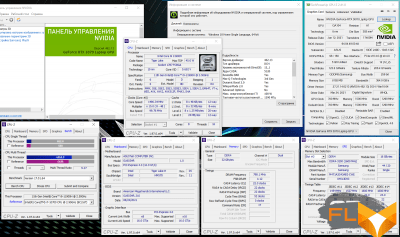 |
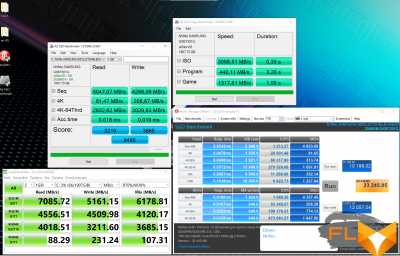 |
As you might guess, the most sophisticated version of the ROG Zephyrus M16 has arrived, because in addition to the 8-core Core i9 and GeForce RTX 3070, the laptop has a 2 TB NVMe SSD and 32 GB of RAM. I did not find a model under the number GU603HR-K8004T for sale, but for the version GU603HR-K8013T (Core i9, GeForce RTX 3070, 16 GB of RAM and 1 TB of SSD) at the time of writing, they asked for $ 3200 in retail. But there are simpler modifications – with Core i7, GeForce RTX 3060, 16 GB of RAM and 1 TB SSD or Core i7, GeForce RTX 3050Ti, 16 GB of RAM and 512 GB of SSD, which are noticeably more affordable – 2400 and 2000 dollars respectively.
The Mediatek MT7921 module, which supports the Wi-Fi 6 standard, is responsible for the wireless connection in the ASUS mobile computer. Using a 160 MHz channel provides a throughput of up to 2.4 Gbps.
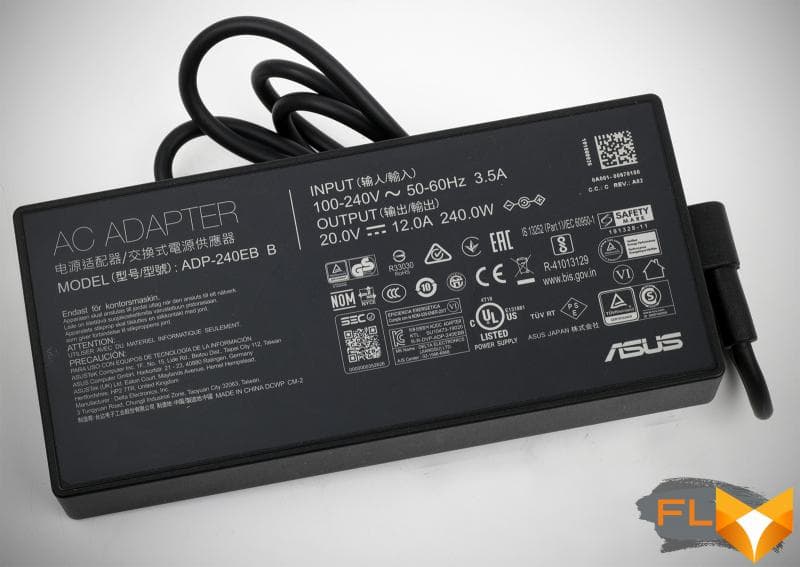
The laptop comes with a 240W external power supply. With all the wires, its weight is just under 600 grams.
⇡#Appearance and Input Devices
The ROG Zephyrus M16 that arrived here is very similar to the G15 and G14 series models we tested this year. So, we got a gray version – the manufacturer uses a more futuristic name Eclipse Gray. The design of the laptop as a whole is recognizable, but also attractive and practical. Even the ROG badge on the metal cover has been removed. It was replaced by a small, almost inconspicuous plate with the inscription “Republic of Gamers. Est. 2006″.
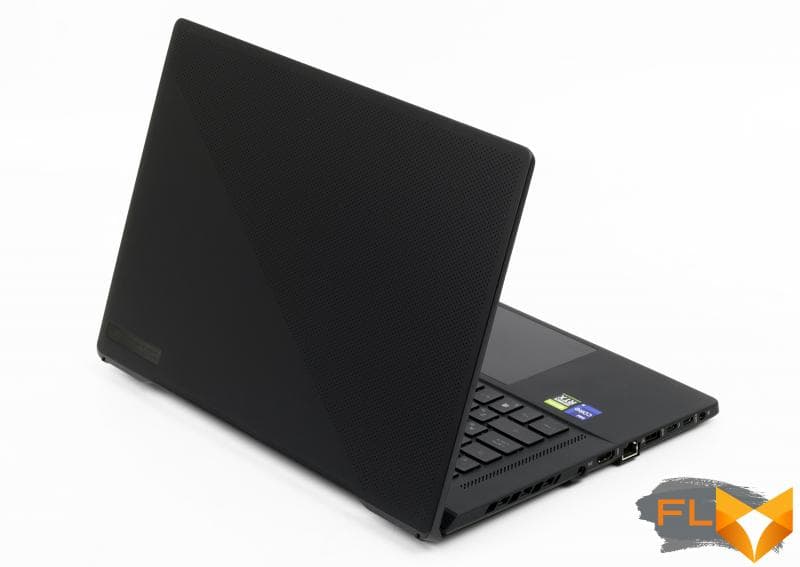
On the metal cover of the case, a pattern is carved, iridescent due to the prismatic film placed below. True, such a pattern also has a minus: 8279 tiny holes are clogged with dust, and over time it will become noticeable.
The surface of the case, on which the keyboard is placed, is covered with a special paint, tactilely reminiscent of soft-touch material. The manufacturer claims that it prevents the appearance of dirty spots and fingerprints, but this is not entirely true. When working on a laptop, handprints still remain. Fortunately, they are easily removed with special cleaning wipes.
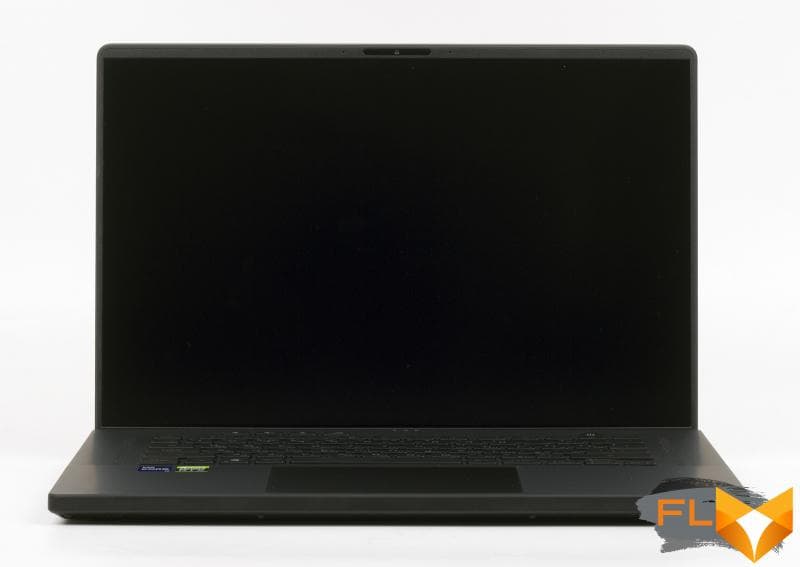
Quote: “The new ROG Zephyrus M16 has a large 16-inch display, while the size of its body corresponds to 15-inch laptops“. Checking the manufacturer’s statement, I found out that the hero of the review received thin bezels: 4 mm on the sides and 9 mm on top. The screen area relative to the entire lid area is 94% – plus in the ROG Zephyrus M16 it was decided not to abandon the built-in webcam. Comparing the data, we see that the dimensions and weight of the 16-inch version of the Zephyrus really do not differ from the characteristics of the previously tested ROG Zephyrus G15. Moreover, the M16 is smaller and lighter than many competitors equipped with 15-inch displays. The 16-inch 16:10 aspect ratio occupies a large area of the top cover. Thanks to special hinges that raise the case, it visually seems that the bottom bezel of the ROG Zephyrus M16 display is 4-6 mm thick, no more.

By the way, about hinges. Yes, the laptop lid opens with one hand, but you have to make a fair amount of effort. At the same time, the maximum opening angle even slightly exceeds 180 degrees. When you open the lid, the base rises an additional few degrees – this trick provides more comfort for the user and frees up additional space for air circulation under the bottom panel of the case. This design feature is also used in the ROG Zephyrus G14/G15.
The other side of the coin is that the laptop cooler throws heated air directly onto the display lid.


Naturally, with this hinge design, all ROG Zephyrus M16 interfaces are located only on the sides of the case. On the left you’ll find HDMI out, RJ-45, USB 3.2 Gen2 A-type, Thunderbolt 4, USB 3.2 Gen 2 Type C, mini-DisplayPort combo and Power Delivery 3.0, and 3.5mm combo headset jack. On the right, there is only a MicroSD 4.0 card reader and USB 3.2 Gen1 A-type. Here, on the sides, there are grilles for the output of heated air.
In my opinion, the number of ports and their location on the ROG Zephyrus M16 case does not raise any questions. Unless you can get drunk due to the lack of a full-fledged card reader that supports SD form factor media. However, this will be a nitpick.
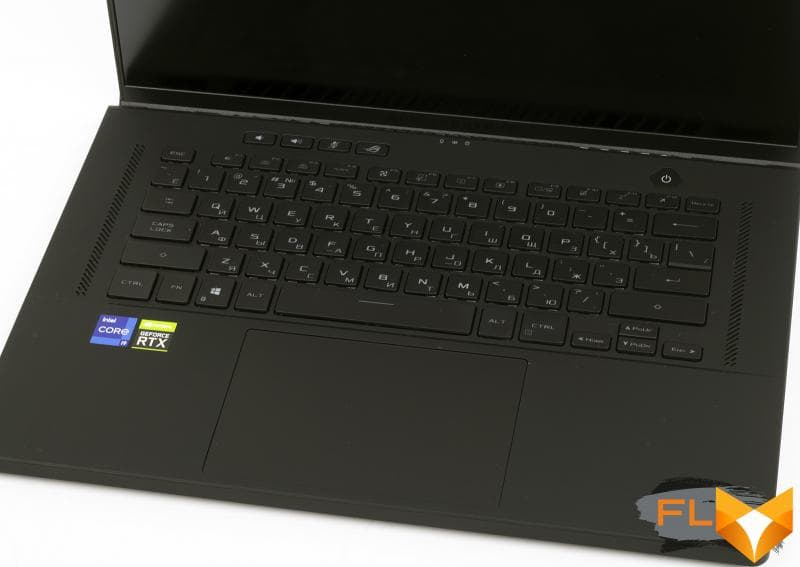
The keyboard and touchpad of the ROG Zephyrus M16 are exactly the same as the HID used in the ROG Zephyrus G15. There is no number pad here, and outwardly the keyboard seems large and spacious. But first-time users of Zephyrus will have to get used to the small arrow keys and a row of F1-F12 buttons. And only by the end of the year I was able to get used to the complete absence of Insert and Print Screen.
But the main buttons (I’m talking about Ctrl, Shift, Tab, Backspace and Enter) are large and comfortable. The travel of each key is 1.7 mm, but the actuation occurs at half the travel. Naturally, ROG’books have backlighting. And the manufacturer also declares support for combinations of any number of keys and a resource of more than 20 million keystrokes.
The power button is located where it should be – away from the rest of the keys. It has a built-in fingerprint sensor that allows you to quickly unlock the system when using the Windows Hello function. Four more keys are placed separately from the main keyboard: with their help, the volume of the speakers is adjusted, and the built-in microphone is turned on and off. Pressing the brand logo button launches the Armory Crate app. The fan button switches between the profiles of the laptop’s cooling system: Silent, Performance and Turbo.
Finally, the brand new touchpad is said to be 20% larger than the HID found in previous generation laptops. Now its dimensions are 13 × 8.5 cm. And the sensor has also begun to work, according to ASUS, 40% faster – this is achieved using the new controller. Well, the glass touchpad panel on the ROG Zephyrus M16 turns out to be nice to the touch and quite comfortable to use – I’m happy with everything.
⇡#Internal design and upgrade options
The bottom of the laptop is quite easy to remove, but after removing 10 screws, you need to act as carefully as possible by picking up the edge of the cover with something thin.

The laptop cooling system uses six heat pipes. Thermal Grizzly liquid metal is applied between the CO sole and the central processor – according to ASUS, it reduces the temperature of the chip by 10 degrees Celsius compared to using conventional thermal paste. This, one might say, is already the hallmark of ROG laptops of the latest generations. The tubes are connected to four copper radiators. Due to the metal thickness of only 0.15 mm, the number of ribs is increased to 252 pieces. In addition, their shape is optimized for the ErgoLift hinge, which lifts the laptop case.
Each Arc Flow fan received 84 blades. The Carlsons are made of liquid crystal polymer, which allows them to be strong but thin. As a result, the engineers were able to increase the airflow by 5% with the same noise level as the previous generation of fans.

Part of the RAM is soldered on the motherboard of the laptop. In the older versions we are talking about 16 GB, in the younger ones – about 8 GB. In our case, an additional memory module is installed in the only SO-DIMM slot, increasing the total RAM capacity to 32 GB. This volume is enough for a long time and for games, and for work applications. But if that’s not enough, the maximum storage capacity of the ROG Zephyrus M16 can be expanded up to 48 GB.
Our model has a 2TB Samsung MZVL22T0HBLB NVMe drive connected to an M.2 slot equipped with four PCI Express 4.0 lanes. If desired, you can install another M.2 SSD in the second slot – only it already supports the PCI Express 3.0 standard.
⇡#Test Methodology
The methodology for testing gaming laptops focuses on computer games. Laptop performance was measured using the following software.
Games (Full HD, WQHD and Ultra HD resolution):
- World of Tanks EnCore RT. DirectX 11. Benchmark. Ultra mode, RT off
- Counter Strike: Global Offensive. DirectX 9. FPS Benchmark map. Multi-core processing – incl. Maximum quality.
- The Witcher III: Wild Hunt. DirectX 11. Novigrad and surroundings. Maximum quality.
- GTA V. DirectX 11. Built-in benchmark. Maximum quality, FXAA + 2x MSAA, advanced quality settings – on, 16x AF, image resolution scaling – off. In 4K – no AA.
- PlayerUnknown’s Battlegrounds. DirectX 11. Training mode. Ultra Mode
- Shadow of the Tomb Raider. DirectX 12. Built-in benchmark. Maximum quality, DXR – off, TAA.
- Assassin’s Creed Valhalla. DirectX 12. Built-in benchmark. Highest mode.
- Battlefield V. DirectX 12. The Last Tiger mission. Ultra Mode, TAA, DXR Off
- Red Dead Redemption 2. Vulkan. Built-in benchmark. Maximum quality (advanced settings – off), TAA.
- Gears 5. DirectX 12. Built-in benchmark. Ultra Mode
- Metro: Exodus. DirectX 12. Built-in benchmark. Ultra Mode
- Horizon Zero Dawn. DirectX 12. Built-in benchmark. Top quality, TAA.
- Death Stranding. DirectX 12 Prologue. Maximum quality.
- A Total War Saga: TROY. DirectX 11. Built-in benchmark. Max mode, 4x AA. In 4K – no AA.
- DOOM Eternal. Vulcan. Beginning of the game. Absolute Nightmare Mode
- Watch Dogs: Legion. DirectX 12. Built-in benchmark. Maximum quality, TAA, DXR off, DLSS off
- Cyberpunk 2077. DirectX 12. City trip. Impressive quality mode, DXR off, DLSS off
Gaming performance was measured using the well-known CapFrameX program. It allows you to get the rendering time of each frame. The use of the 99th percentile instead of the minimum frames per second is due to the desire to clean up the results from random performance fluctuations that were provoked by reasons not directly related to the operation of the main components of the platform.
Testing the laptop in games and applications was carried out with the activation of the fastest mode suitable for these tasks.
Applications:
- Corona 1.3. Testing rendering speed using the renderer of the same name. Measures the build speed of the standard BTR scene used to measure performance.
- Blender 2.93.1. Determining the speed of the final rendering in one of the popular free packages for creating three-dimensional graphics. The duration of building the final model pavillon_barcelona_v1.2 from Blender Benchmark is measured.
- x265 HD Benchmark. Testing the speed of video transcoding to H.265/HEVC format. The tables and graphs show the average integer value obtained after five runs of the test.
- CINEBENCH R23. Performance measurement of photorealistic 3D rendering in CINEMA 4D animation package, CPU test. The tables and graphs show the average integer value obtained after five runs of the test.
- Adobe Premiere Pro 2020 – Rendering a project in 4K resolution.
Comprehensive benchmarks:
- Futuremark PCMARK10 Professional Edition 2.1.2177. Testing in Essentials scenarios (typical work of an average user: launching applications, surfing the Internet, video conferencing), Productivity (office work with a text editor and spreadsheets), Digital Content Creation (creation of digital content: photo editing, non-linear video editing, 3D rendering and visualization -models).
- 3DMark Professional Edition 2.11.6846. Testing in Time Spy and Fire Strike scenes.
- Unigine Superposition Benchmark. 1080p Extreme testing.
Notebook testing in resource-intensive applications was carried out in the default mode without any additional settings for the CPU and cooler. Display testing is performed using the X-Rite i1Display Pro colorimeter and the DisplayCAL 3 application.
The battery life of the laptop was tested in two modes. The first load option – web surfing – involves alternately opening and closing the tabs of the Computeruniverse.ru and Unsplash.com sites with an interval of 30 seconds. For this test, the current version of the Google Chrome browser at the time of testing is used. In the second mode, video in .mkv format and Full HD resolution is played in the built-in player of Windows OS with the repeat function activated. In all cases, the same display brightness was set to 200 cd / m2, and the keyboard backlight (if any) and the sound were turned off.
In games and other applications, the results of the following laptops are considered:
| Test participants | ||||||
| Model | Screen | Processor | RAM | Graphics | Drive | Battery |
| ASUS ROG Strix G15 Advantage Edition G513QY | 15.6″, 1920 × 1080 | AMD Ryzen 9 5900HX 8/16 cores/threads 3.3 (4.6) GHz 45W | 16 GB DDR4-3200 Dual Channel | AMD Radeon RX 6800M 12GB GDDR6 | SSD, 1TB | 90 Wh |
| Acer Predator Triton 500 SE | 16″, 2560 × 1600 | Intel Core i9-11900H, 8/16 cores/threads, 2.5 (4.9) GHz, 45W | 32 GB DDR4-3200 Dual Channel | NVIDIA GeForce RTX 3080 Notebook 8GB GDDR6 | 2TB SSD | 99.9 Wh |
| ASUS ROG Zephyrus M16 GU603HR | 16″, 2560 × 1600 | Intel Core i9-11900H, 8/16 cores/threads, 2.5 (4.9) GHz, 45W | 32 GB DDR4-3200 Dual Channel | NVIDIA GeForce RTX 3070 Notebook 8GB GDDR6 | 2TB SSD | 90 Wh |
⇡#Display and Sound
As said, the highlight of any ROG Zephyrus M16 is the 16:10 aspect ratio display. Some models use an IPS-matrix with a resolution of 1920 × 1200 pixels, a vertical frequency of 144 Hz and a response time of 3 ms. In our case, a display with a resolution of 2560 × 1600 pixels, a frequency of 165 Hz and a response time of 3 ms was used. For all assemblies, support for Adaptive-Sync is declared.
The test model received an excellent display – we are talking about the B156QAN02.2 matrix from AU Optronics. The screen has high brightness and good contrast. The color gamut complies with the DCI-P3 standard. The color error is small, so ROG Zephyrus M16 can be recommended not only to gamers, but also to those who work with graphics, photos and videos.
| ASUS ROG Zephyrus M16 GU603HR (Matrix – AU Optronics B156QAN02.2) | |
| Minimum brightness | 23 cd/m2 |
| Maximum brightness | 433 cd/m2 |
| Color temperature | 6767K |
| Contrast | 980:1 |
| sRGB gamut | 99% |
| Adobe RGB color gamut | 87% |
| Grey scale deviation: average (maximum) | 0.94 (1.89) |
| Extended test deviation: mean (maximum) | 1.11 (6.4) |
| Viewing angles | As stated |
| Glow effect | Present |
| PWM | Unseen at all brightness levels |
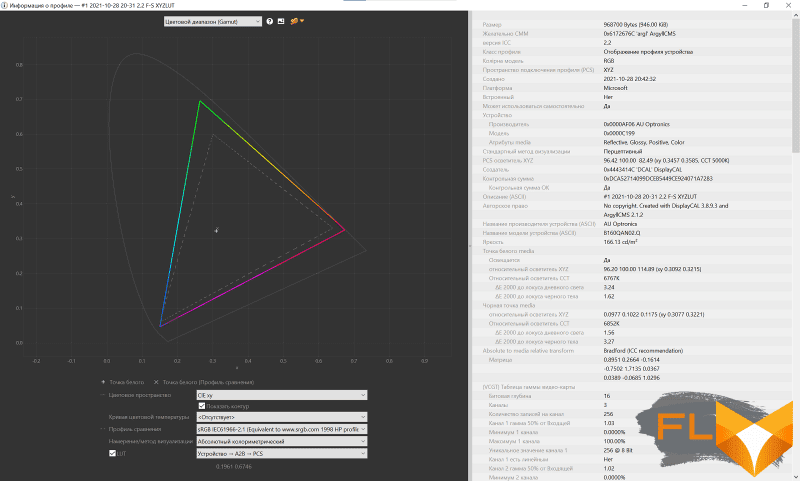
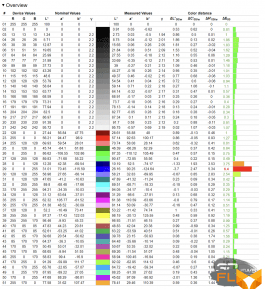 |
 |
 |
And Zephyrus traditionally have a cool sound – by laptop standards, of course. And the ROG Zephyrus M16 is no exception. The design of the laptop used six speakers at once (two high-frequency and two pairs of low-frequency). When listening to musical compositions, the bass is not bad, and the highs and mids sound quite natural.
⇡#Efficiency of the cooling system
The Armory Crate program has three manufacturer-prepared laptop operating modes: “Quiet”, “Efficiency” and “Turbo”.
| Summary of laptop operation and setup in games | |||
| Laptop Mode | “Turbo” | “Efficiency” |
“Quiet“ |
| Declared GPU Speed (Boost) and Memory Speed | 1390 MHz, 12.24 Gbps | 1290 MHz, 12 Gbps | 1290 MHz, 12 Gbps |
| Cyberpunk 2077 Real Average GPU Frequency | 1529 MHz | 1422 MHz | 725 MHz |
| Max noise level | 48 dBA | 45.5 dBA | 36.4 dBA |
| Average Power: GPU, CPU | 100W | 93W | 51W |
| 17W | 16W | 11W | |
| GPU Temperature: Average, Maximum | 74 °C | 76 °C | 69 °C |
| 75 °C | 77°C | 70 °C | |
| CPU temperature: average, maximum | 72 °C | 73 °C | 69 °C |
| 77 °C | 82 °C | 90 °C | |
| Performance | |||
| 3DMark Time Spy, points | 9614 | 8625 | 5538 |
| 3DMark Fire Strike scores | 21800 | 20218 | 13288 |
| Unigine Superposition, 1080p Extreme, баллы | 6415 | 5964 | 3872 |
|
Режим «Турбо» |
Mode “Efficiency” |
Quiet Mode |
Heating laptop case (games, Turbo mode)
The “Quiet” mode is activated when the laptop is disconnected from the mains – it is obvious that it is also intended to extend the battery life of a mobile PC. Testing shows that the performance of the GeForce RTX 3070 is seriously reduced, but even this speed in some cases will be enough to get a comfortable FPS in games. In this case, the laptop will work very quietly.
Unfortunately, the “Turbo” and “Efficiency” modes cannot be called quiet. Yes, the ROG Zephyrus M16 is noticeably noisy, but this is a price to pay for a fairly high level of performance and effective cooling of the main components of the laptop. The maximum heating of the GeForce RTX 3070 chip in Turbo mode was only 75 degrees Celsius. We can see that the GPU works within the manufacturer’s declared power consumption figures. True, it is worth considering that Dynamic Boost technology can work differently even within the same game.
As already mentioned, the heated air is partially blown directly onto the laptop display. This is clearly visible in the image of the thermal imager, and in general the upper area with the keys (row F1-F12) noticeably heats up.
In CPU-intensive applications, the average power consumption of the Core i9-11900H is 72W in Turbo mode and 49W in Efficiency mode. We see that the use of liquid metal allows the 8-core Intel to work with a noticeable excess of the standard TDP level (45 W) – even if the CPU temperature reaches peak values for a short time, and the laptop is noisy.
| The efficiency of the laptop cooling system in the CINEBENCH R23 program | ||||
| “Turbo” | “Efficiency“ | “Quiet“ | ||
| CPU frequency | Medium | 3.8GHz | 3.2GHz | 2.7GHz |
| CPU Temperature | Maximum | 94 °C | 96 °C | 87 °C |
| Medium | 84 °C | 78 °C | 74 °C | |
| Noise level | Maximum | 50 dBA | 47 dBA | 37.3 dBA |
| CPU Power Consumption | Medium | 72W | 49 W | 30W |
| Performance (bigger is better) | 12569 points | 10520 points | 8725 points | |
|
Turbo Mode |
Mode “Efficiency” |
Quiet Mode |
⇡#Performance
Well, we’ve found that the ROG Zephyrus M16 is ultra-efficient in Turbo mode. I propose to compare the performance of this model with the performance of the Predator Triton 500 SE, which also uses a WQXGA display.
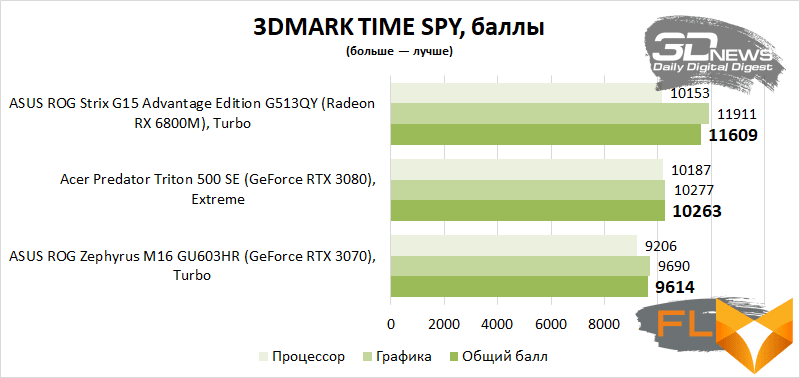
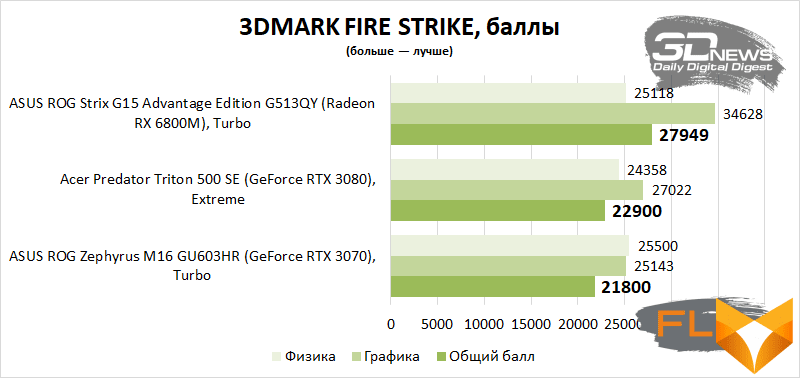
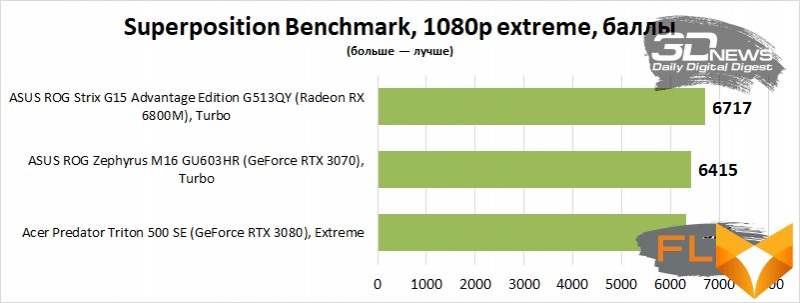
The Acer laptop is slightly faster in 3DMARK benchmarks thanks to the 100-watt GeForce RTX 3080. True, the Zephyrus lags only 6% in the Time Spy test and 5% in Fire Strike. And in the Unigine Superposition, the ASUS laptop turned out to be faster, albeit by a symbolic 1%. The results obtained clearly show that the performance of a laptop needs to be assessed comprehensively, and the presence of a faster graphics processor in the characteristics does not at all guarantee more FPS in games. It is important to take into account the work of other components of the laptop (central processor and memory), as well as their mode of operation, because one manufacturer squeezes the maximum out of the hardware installed in the laptop, while the other tries to find a compromise between performance and noise levels.
Speaking of ROG Zephyrus M16, its power should be considered sufficient for games in WQXGA resolution. Unless in Cyberpunk 2077 you will have to lower the quality of the graphics, change the resolution or enable DLSS anti-aliasing in order to get a comfortable FPS.
I will note one more feature that is important for laptops with an aspect ratio of 16:10. Unfortunately, not all games support this format in full. In most cases, AAA projects work well at 2560 × 1600 and 1920 × 1200 pixels, but screensavers, cutscenes, dialogues, menus (inventory, character stats) and cut scenes that use the game engine are played in 16:9, leaving black stripes above and below. This one can upset gamers prone to perfectionism, but for me personally, cinematic stripes (by the way, in some games this effect is used by developers quite intentionally) will not scare me away from buying such a device – it would be a good laptop.
| Game testing results, FPS (more is better) | ||||
| 2560 × 1600 | 1920 × 1200 | |||
| AVG | 1% MIN | AVG | 1% MIN | |
| World of Tanks | 129 | 88 | 194 | 131 |
| CS: GO | 287 | 67 | 384 | 101 |
| PlayerUnknown’s Battlegrounds | 116 | 78 | 136 | 97 |
| The Witcher III: Wild Hunt | 75 | 48 | 98 | 62 |
| GTA V | 73 | 54 | 86 | 64 |
| Shadow of the Tomb Raider | 68 | 52 | 89 | 60 |
| Assassin’s Creed Valhalla | 52 | 40 | 65 | 48 |
| Red Dead Redemption 2 | 53 | 44 | 66 | 54 |
| Gears 5 | 67 | 53 | 93 | 67 |
| Metro: Exodus | 53 | 32 | 67 | 37 |
| A Total War Saga: TROY | 49 | 39 | 69 | 55 |
| Horizon Zero Dawn | 68 | 45 | 90 | 61 |
| Watch Dogs: Legion | 50 | 36 | 65 | 48 |
| Battlefield V | 82 | 52 | 104 | 74 |
| Cyberpunk 2077 | 34 | 25 | 55 | 39 |
| DOOM Eternal | 119 | 60 | 170 | 85 |
| Death Stranding | 96 | 79 | 108 | 86 |
*Death Stranding used Full HD and WQHD resolutions.

ROG Zephyrus M16 does not give in to resource-intensive tasks either. However, we have already found out that the Core i9-11900H installed in it goes beyond the declared power limits during operation.



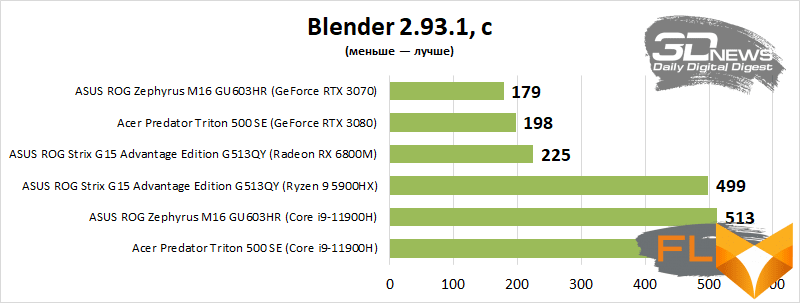

Below are the results of testing the laptop in the PCMARK 10 comprehensive benchmark.
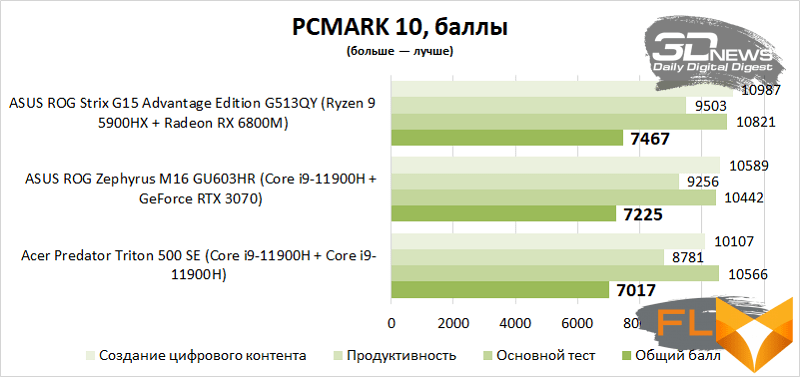
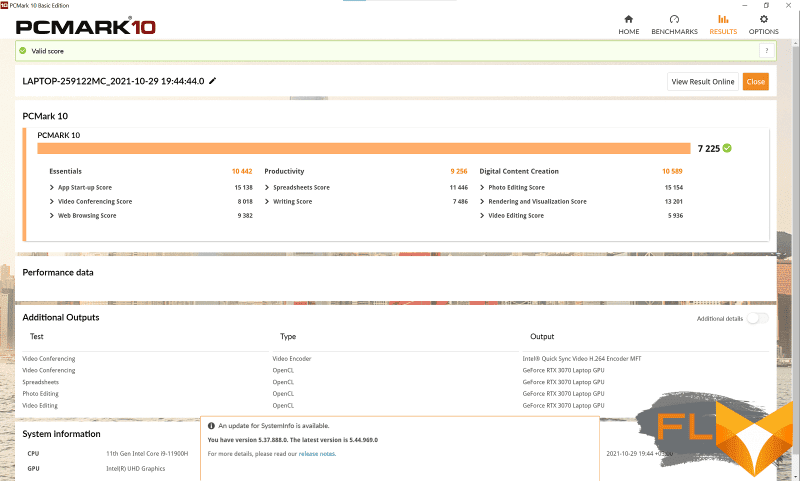
⇡#Offline work
The laptop comes with a 90 Wh battery. The previously mentioned ROG Zephyrus G15 GA503 uses exactly the same battery, and this model impressed us with its endurance in its time. So, in the modes of web surfing and video viewing, the laptop worked for a little more than 10 hours.
As you can see, ROG Zephyrus M16 shows more modest results. And still, the autonomy of the hero of the review can be considered good. I believe that the less survivability of this “Zephyrus” is due to the use of a more “gluttonous” WQXGA display and, in general, a less energy efficient Intel platform.
Another thing is that the battery life of a gaming laptop is a parameter that can only be given a subjective assessment. Someone will buy a ROG Zephyrus M16 and use it as a desktop replacement. In this case, the battery of this mobile PC will work, in fact, as a UPS. And someone really needs to have as tenacious a laptop as possible. And this is where the ROG Zephyrus M16 has an accelerated charging function – when turned off, using the included power supply, you can charge the battery from 0 to 50% in just 30 minutes. And the laptop also supports USB Power Delivery 3.0 – on business trips, it is not necessary to carry a large and heavy PSU with you. A full charge cycle of the ROG Zephyrus M16 battery lasts 2 hours.
| Battery life, screen brightness 200 cd/m2 | |
| Web | 6 hours 30 minutes |
| View video | 9 hours 44 minutes |
⇡#Conclusions
The tested laptop has many advantages, and I decided to put the use of the WQXGA matrix at the forefront – to make it the cherry on the cake called the ROG Zephyrus M16. The display in the laptop, by the way, is really used excellent, and this, whatever one may say, is an important component of any mobile PC.
You can only find fault with the settings of the ROG Zephyrus M16 cooling system – in most cases, the computer is quite noisy. But to the reverse side of this medal – the level of performance and heating – I personally have no complaints. Especially considering that we are dealing with a fairly compact and lightweight “15”16-inch model. Everything is good with Zephyrus and with build quality, case and its materials, as well as functionality, upgradeability and built-in sound. Autonomy is in order, and if suddenly such survivability of the ROG Zephyrus M16 is not enough, then fast charging functions and support for Power Delivery 3.0 will help.






